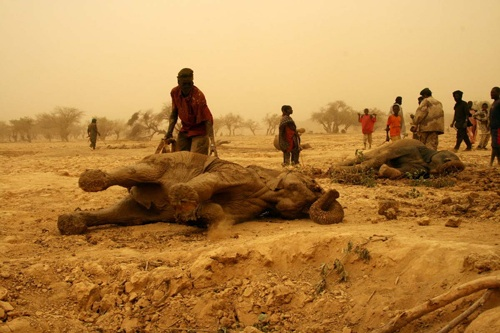Amid historic drought, Red Cross buys starving cattle to feed Malians — ‘Dead animals litter the ground’
Toya, Mali (AFP) June 22, 2010 – In single file, hundreds of residents of Toya wait patiently for meat distributed by the Red Cross who bought up thousands of starving animals to feed Mali’s drought-stricken population. With containers in hand they await the meat from four cows slaughtered in the village in the north-west of the country last week which had lost too much weight from lack of grazing and water. Children scream with joy at the prospect of the meat coming their way. “The International Committee of the Red Cross (ICRC) operation is original and benefits the farmers as well as the population,” says Mohamed Ali, local ICRC representative for the town in the Timbuktu region, some 900 kilometres (560 miles) north-east of the capital Bamako. “With the drought, the animals don’t have anything to eat and drink. Then the ICRC buys the weakest animals, kills and distributes the meat to the needy. The farmer wins because of the money, the people too,” says Ali. In northern Mali and northern Niger, the ICRC seeks to buy “38,000 head of cattle from 10,000 families of farmers and farmers affected by the cumulative effects of insecurity and drought,” according to the organization. … Along the roads in this region of Timbuktu, dead animals litter the ground. Dead from thirst. Ponds that usually contain water at this time of year are empty. Birds peck listlessly at the sand before flying off. “There is a sense of powerlessness within us. You see a cow which is thirsty, you can’t do anything. It dies in front of you. And you are more concerned with saving the rest of your flock,” says Atoume, a young farmer in northern Mali. In the regions of Gao and Kidal, “it is worse,” said Mahamane Dicko, a municipal councillor for the town of Douenzta, between Mopti and Gao. “I have just come from these areas. In some parts more than 70 percent of livestock has been decimated by the drought,” said Dicko. …
Amid drought, Red Cross buys starving cattle to feed Malians
